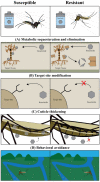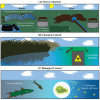Chemical Control of Mosquitoes and the Pesticide Treadmill: A Case for Photosensitive Insecticides as Larvicides
- PMID: 36555003
- PMCID: PMC9783766
- DOI: 10.3390/insects13121093
Chemical Control of Mosquitoes and the Pesticide Treadmill: A Case for Photosensitive Insecticides as Larvicides
Abstract
Insecticides reduce the spread of mosquito-borne disease. Over the past century, mosquito control has mostly relied on neurotoxic chemicals-such as pyrethroids, neonicotinoids, chlorinated hydrocarbons, carbamates and organophosphates-that target adults. However, their persistent use has selected for insecticide resistance. This has led to the application of progressively higher amounts of insecticides-known as the pesticide treadmill-and negative consequences for ecosystems. Comparatively less attention has been paid to larvae, even though larval death eliminates a mosquito's potential to transmit disease and reproduce. Larvae have been targeted by source reduction, biological control, growth regulators and neurotoxins, but hurdles remain. Here, we review methods of mosquito control and argue that photoactive molecules that target larvae-called photosensitive insecticides or PSIs-are an environmentally friendly addition to our mosquitocidal arsenal. PSIs are ingested by larvae and produce reactive oxygen species (ROS) when activated by light. ROS then damage macromolecules resulting in larval death. PSIs are degraded by light, eliminating environmental accumulation. Moreover, PSIs only harm small translucent organisms, and their broad mechanism of action that relies on oxidative damage means that resistance is less likely to evolve. Therefore, PSIs are a promising alternative for controlling mosquitoes in an environmentally sustainable manner.
Keywords: Culicidae; Diptera; insect control; insecticide resistance; pest management; photoactive; photodynamic; reactive oxygen species.
Conflict of interest statement
The authors declare no conflict of interest. The funders had no role in the design of the review; in the interpretation of the scientific literature; in the writing of the manuscript; or in the decision to publish.
Figures








Similar articles
-
Yeast encapsulation of photosensitive insecticides increases toxicity against mosquito larvae while protecting microorganisms.PLoS One. 2024 Oct 29;19(10):e0310177. doi: 10.1371/journal.pone.0310177. eCollection 2024. PLoS One. 2024. PMID: 39471141 Free PMC article.
-
Mosquito larvae exposed to a sublethal dose of photosensitive insecticides have altered juvenile development but unaffected adult life history traits.Parasit Vectors. 2023 Nov 11;16(1):412. doi: 10.1186/s13071-023-06004-8. Parasit Vectors. 2023. PMID: 37951916 Free PMC article.
-
Plant-mediated biosynthesis of nanoparticles as an emerging tool against mosquitoes of medical and veterinary importance: a review.Parasitol Res. 2016 Jan;115(1):23-34. doi: 10.1007/s00436-015-4800-9. Epub 2015 Nov 5. Parasitol Res. 2016. PMID: 26541154 Review.
-
Impact of deltamethrin-resistance in Aedes albopictus on its fitness cost and vector competence.PLoS Negl Trop Dis. 2021 Apr 27;15(4):e0009391. doi: 10.1371/journal.pntd.0009391. eCollection 2021 Apr. PLoS Negl Trop Dis. 2021. PMID: 33905415 Free PMC article.
-
Environmental safety review of methoprene and bacterially-derived pesticides commonly used for sustained mosquito control.Ecotoxicol Environ Saf. 2017 May;139:335-343. doi: 10.1016/j.ecoenv.2016.12.038. Epub 2017 Feb 7. Ecotoxicol Environ Saf. 2017. PMID: 28187397 Review.
Cited by
-
Incorporating citizen science engagement in a vector surveillance undergraduate internship.Discov Educ. 2024;3(1):191. doi: 10.1007/s44217-024-00293-6. Epub 2024 Oct 21. Discov Educ. 2024. PMID: 39445030 Free PMC article.
-
Making scents of mosquito repellents.Trends Parasitol. 2025 Apr;41(4):280-289. doi: 10.1016/j.pt.2025.02.009. Epub 2025 Mar 10. Trends Parasitol. 2025. PMID: 40068978 Review.
-
Larvicidal Activity of Extracts from the Artemisia arborescens L. Plant and Hyrtios erectus Sponge Against the Culex pipiens Mosquito (Diptera: Culicidae) and Toxicological Assessment on Danio rerio Zebrafish Embryos as Non-Target Organism.Insects. 2025 Apr 24;16(5):448. doi: 10.3390/insects16050448. Insects. 2025. PMID: 40429161 Free PMC article.
-
Seroprevalence of Chikungunya and O'nyong-nyong Viruses in Senegal, West Africa.J Med Virol. 2025 Mar;97(3):e70282. doi: 10.1002/jmv.70282. J Med Virol. 2025. PMID: 40028687 Free PMC article.
-
Yeast encapsulation of photosensitive insecticides increases toxicity against mosquito larvae while protecting microorganisms.PLoS One. 2024 Oct 29;19(10):e0310177. doi: 10.1371/journal.pone.0310177. eCollection 2024. PLoS One. 2024. PMID: 39471141 Free PMC article.
References
-
- WHO . Global Vector Control Response 2017–2030. WHO; Geneva, Switzerland: 2017. p. 53.
-
- da Silva A.F., Machado L.C., de Paula M.B., da Silva Pessoa Vieira C.J., de Morais Bronzoni R.V., de Melo Santos M.A.V., Wallau G.L. Culicidae evolutionary history focusing on the Culicinae subfamily based on mitochondrial phylogenomics. Sci. Rep. 2020;10:18823. doi: 10.1038/s41598-020-74883-3. - DOI - PMC - PubMed
-
- Becker N., Petric D., Zgomba M., Boase C., Dahl C., Madon M., Kaiser A. Mosquitoes and Their Control. 2nd ed. Springer; Berlin/Heidelberg, Germany: 2010. p. 577.
Publication types
Grants and funding
LinkOut - more resources
Full Text Sources
Miscellaneous

